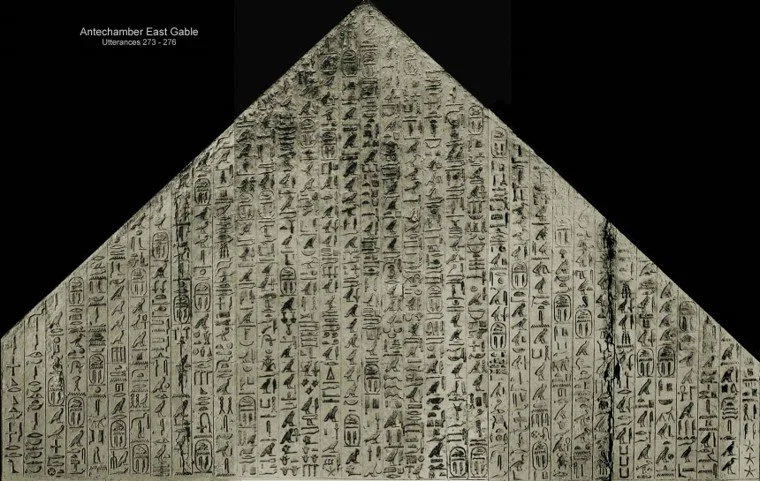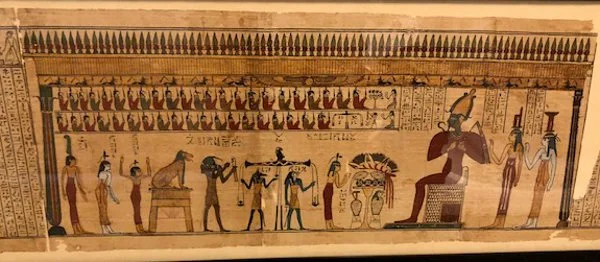Read All About It: The Book of the Dead, Pyramid Texts, and Coffin Texts
Welcome back, fellow explorers! Today, we’re diving into some of the most famous—and essential—texts of ancient Egypt that guided souls on their journey to the afterlife. These aren’t just your everyday ancient writings; we’re talking about the Book of the Dead, Pyramid Texts, and Coffin Texts—the ultimate guides to navigating the afterlife and securing a place in paradise.
The tomb and sarcophagus of Unas - the last of the Old Kingdom pharaohs. Here you see the tomb is full of Pyramid Texts.
The Pyramid Texts: A Royal Affair
Let’s start at the beginning—the Pyramid Texts. These are the oldest religious writings known in ancient Egypt, dating all the way back to the Old Kingdom (around 2400 BCE). They were reserved exclusively for royalty, specifically for the pharaohs and their queens. Think of these texts as the VIP pass to the afterlife!
The Pyramid Texts were inscribed directly onto the walls of the pyramids—hence the name—and consisted of spells, incantations, and instructions aimed at protecting the king’s body and helping his spirit ascend to the heavens. These texts didn’t just focus on reaching the Field of Reeds but emphasized the pharaoh’s divine right to join the gods in the sky. It's a royal roadmap to eternity.
One of the most famous spells, known as the “Cannibal Hymn,” even describes the pharaoh consuming the gods to absorb their power and secure his eternal rule. These spells often evoke powerful imagery of the pharaoh becoming one with the cosmos, the stars, and the gods.
The Coffin Texts: Opening Up to the Masses
As we move forward to the Middle Kingdom (around 2000 BCE), we see a shift in the afterlife game. The exclusivity of the Pyramid Texts gave way to the Coffin Texts, making sacred writings accessible to nobles and wealthy individuals, democratizing the afterlife experience.
The Coffin Texts were inscribed inside coffins, adapting the core elements of the Pyramid Texts for the non-royal elite. Now, Egyptians who weren’t royalty could secure a spot in the afterlife by following the guidelines laid out on their coffins.
These texts offered a broader view of the afterlife, including protective spells and practical instructions for navigating the perils of the Duat (the Egyptian underworld). Filled with depictions of monsters, demons, and obstacles, the Coffin Texts helped guide the deceased safely toward the Field of Reeds—though it was certainly a perilous journey.
The Ani Papyrus- Book of the Dead - from The Trustees of the British Museum. Shared under a Creative Commons Attribution-NonCommercial-ShareAlike 4.0 International (CC BY-NC-SA 4.0) licence.
The Book of the Dead: The Ultimate Guide
Now, let’s talk about the superstar of Egyptian funerary texts—the Book of the Dead. This collection of magical spells, written on papyrus scrolls, became popular during the New Kingdom (around 1550 BCE). The Book of the Dead wasn’t just a guide to the afterlife; it was a personalized tool to help individuals make a smooth transition into the next world.
The Book of the Dead wasn’t a single fixed text but rather a customizable collection of spells. Wealthy Egyptians could commission their scrolls and select specific spells to help navigate the underworld and protect their souls.
One of the most iconic scenes associated with the Book of the Dead is the Weighing of the Heart ceremony, a pivotal moment in the soul’s journey. In this ritual, the heart of the deceased was weighed against the Feather of Ma’at, the goddess of truth and justice. If the heart was pure, the soul was granted entry into the Field of Reeds. But if it was heavy with wrongdoing, the heart was devoured by Ammit, the fearsome beast waiting nearby.
A fun fact: The Book of the Dead included the “Negative Confession,” where the deceased would list all the wrongs they hadn’t committed in life—essentially an ancient Egyptian good-behavior checklist!
How These Texts Shaped the Afterlife
The Pyramid Texts, Coffin Texts, and Book of the Dead all served one major purpose: guiding the deceased safely through the afterlife and ensuring their transition to a peaceful eternity. They reflect the Egyptians’ deep belief in the afterlife as a continuation of earthly existence, but on a grander, more divine scale.
These texts were the Egyptians' ultimate roadmaps to eternity, offering protection, guidance, and transformation for the soul. Every detail, from protecting the body to allowing the soul to fly among the gods, was meticulously planned and inscribed.
Why These Texts Still Matter Today
Why should we care about these ancient texts today? They offer valuable insights into how the Egyptians viewed life, death, and the universe. These writings are a testament to the power of ritual and belief in shaping one's destiny and provide a window into the values that guided an entire civilization.
More importantly, these texts remind us of universal human desires—eternal life, the fear of judgment, and the hope for reunion with loved ones. Themes like these resonate across cultures and eras, making the wisdom of the Egyptians timeless.
Wrapping It Up
Whether carved on the walls of pyramids, written on coffins, or penned on papyrus scrolls, these texts represent the Egyptians’ roadmaps to the afterlife. They were guides, protectors, and companions on the soul’s journey to eternal life.
And if you’re as fascinated as I am, why not experience the magic of Egypt firsthand? With Kemet Spiritual Journeys, you can explore these incredible sites, see the tombs where these sacred texts were written, and uncover the mysteries of ancient Egyptian life. Plan your trip today at kemetspiritualjourneys.com, where your Egyptian adventure will be fully customized to your interests and wishes! 🌟




